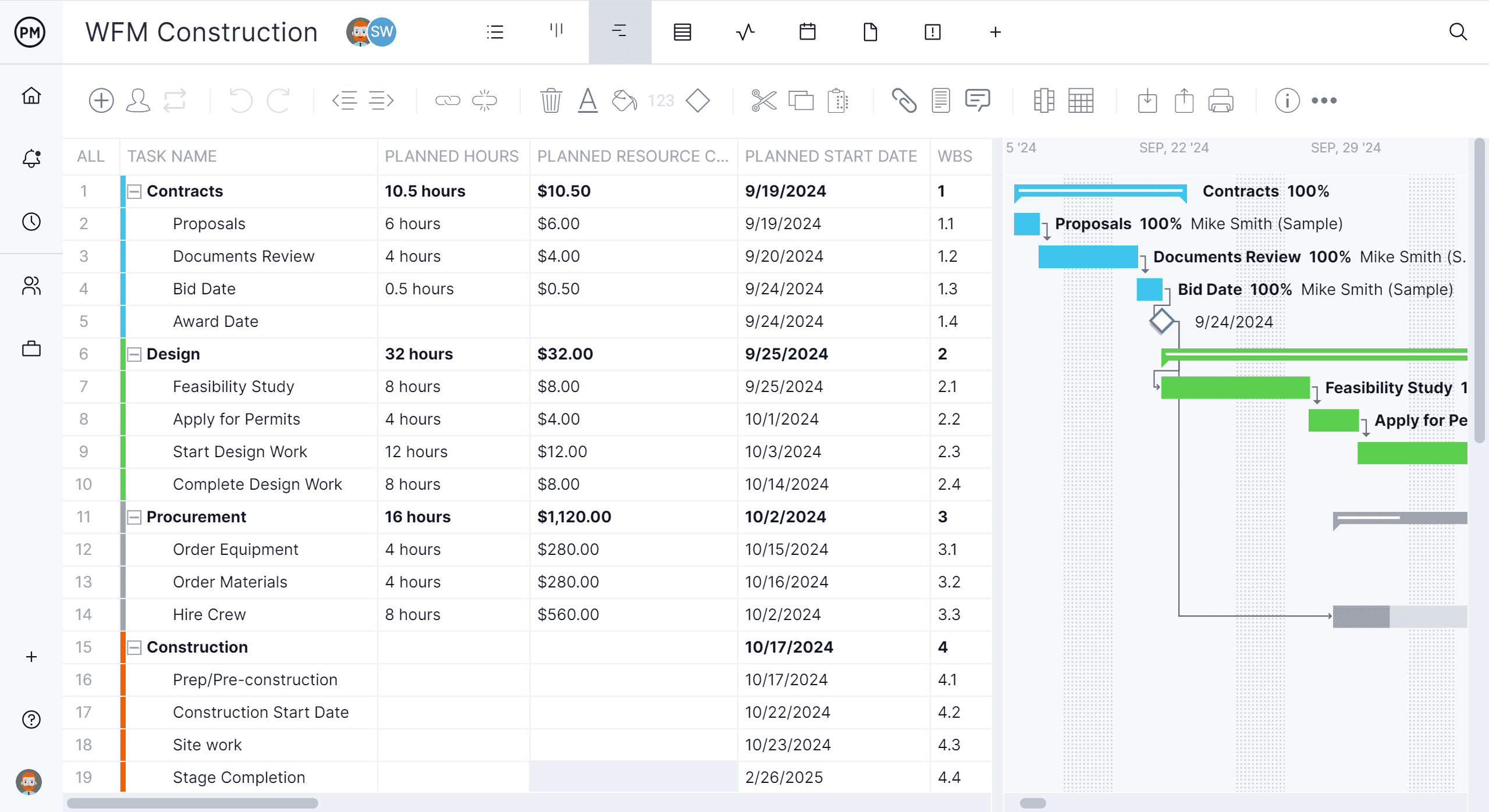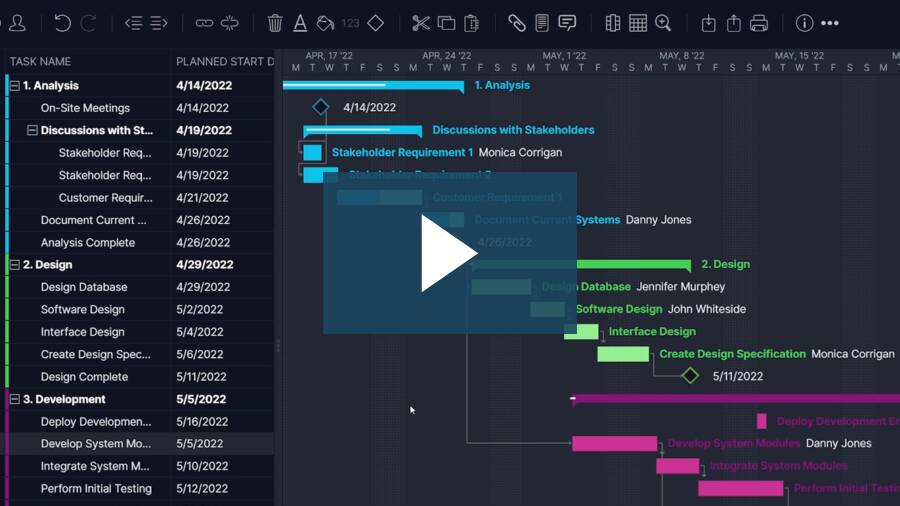- What Is the Waterfall Methodology in Project Management?
- The Phases of the Waterfall Model
- Waterfall Software Development Life Cycle
- What Is Waterfall Software?
- Desktop vs Online Waterfall Software
- Must-Have Features of Waterfall Software
- The Waterfall Model & ProjectManager.com
- Waterfall vs. Agile
- Pros & Cons of the Waterfall Model
- Benefits of Project Management Software for Waterfall Projects
- Waterfall Methodology Resources
What Is the Waterfall Methodology in Project Management?
The waterfall methodology is a linear project management approach, where stakeholder and customer requirements are gathered at the beginning of the project, and then a sequential project plan is created to accommodate those requirements. The waterfall model is so named because each phase of the project cascades into the next, following steadily down like a waterfall.
It’s a thorough, structured methodology and one that’s been around for a long time, because it works. Some of the industries that regularly use the waterfall model include construction, IT and software development. As an example, the waterfall software development life cycle, or waterfall SDLC, is widely used to manage software engineering projects.
Related: 15 Free IT Project Management Templates for Excel & Word
Gantt charts are the preferred tool for project managers working in waterfall method. Using a Gantt chart allows you to map subtasks, dependencies and each phase of the project as it moves through the waterfall lifecycle. ProjectManager’s waterfall software offers these features and more.
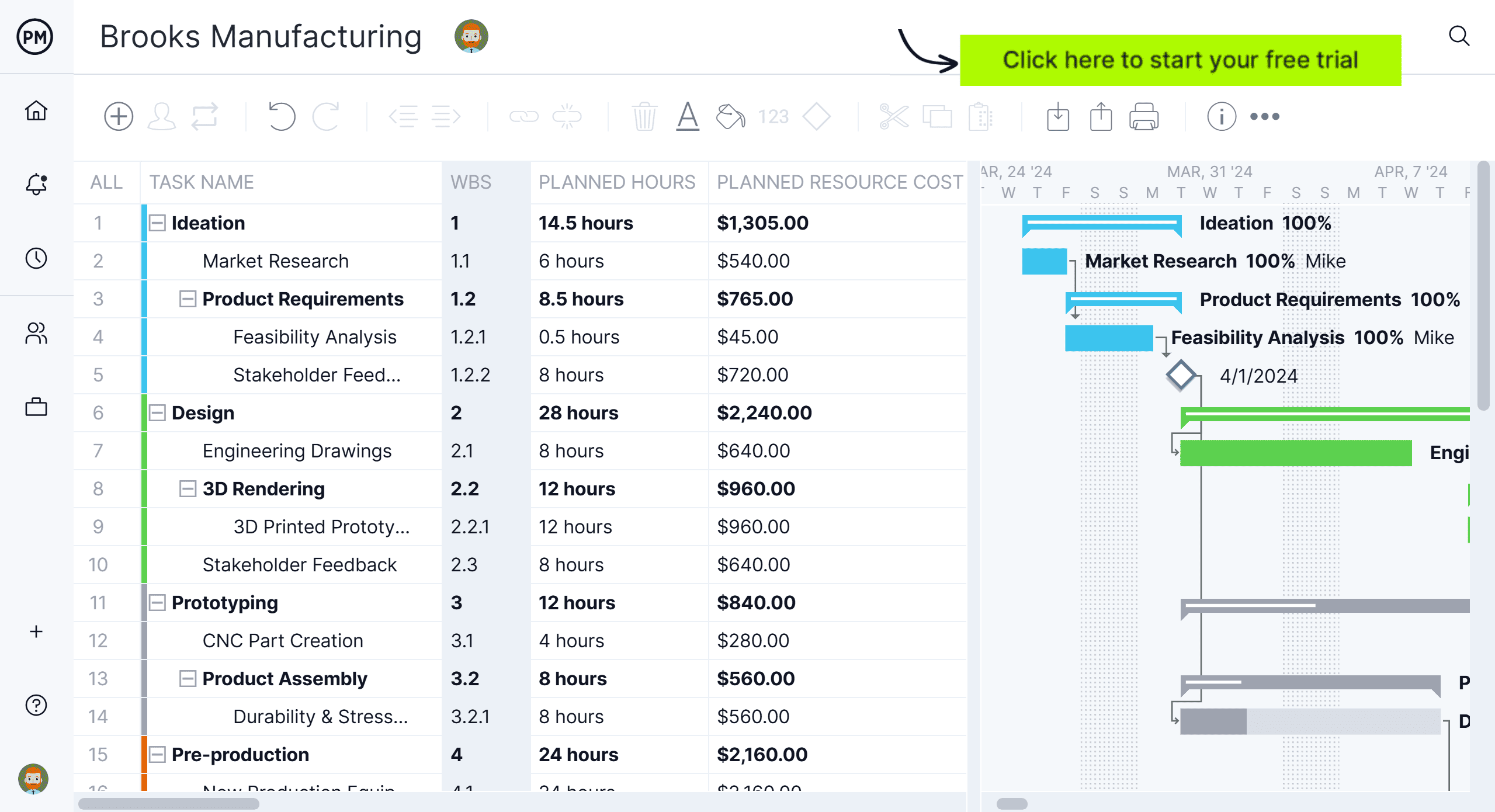
Make detailed waterfall plans with WBS and dependencies in ProjectManager—learn more.
The Phases of the Waterfall Model
The waterfall approach has, at least, five to seven phases that follow in strict linear order, where a phase can’t begin until the previous phase has been completed. The specific names of the waterfall steps vary, but they were originally defined by its inventor, Winston W. Royce, in the following way:
Requirements: The key aspect of the waterfall methodology is that all customer requirements are gathered at the beginning of the project, allowing every other phase to be planned without further customer correspondence until the product is complete. It is assumed that all requirements can be gathered at this waterfall management phase.
Design: The design phase of the waterfall process is best broken up into two subphases: logical design and physical design. The logical design subphase is when possible solutions are brainstormed and theorized. The physical design subphase is when those theoretical ideas and schemas are made into concrete specifications.
Implementation: The implementation phase is when programmers assimilate the requirements and specifications from the previous phases and produce actual code.
Verification: This phase is when the customer reviews the product to make sure that it meets the requirements laid out at the beginning of the waterfall project. This is done by releasing the completed product to the customer.
Maintenance: The customer is regularly using the product during the maintenance phase, discovering bugs, inadequate features and other errors that occurred during production. The production team applies these fixes as necessary until the customer is satisfied.
Related: Free Gantt Chart Template for Excel
Waterfall Software Development Life Cycle
Let’s hypothesize a simple project, then plan and execute it with the waterfall approach phases that you just learned. For our waterfall software development life cycle example, we’ll say that you’re building an app for a client. The following are the steps you’d take to reach the final deliverable.
Requirements & Documents
First, you must gather all the requirements and documentation you need to get started on the app.
- Project Scope: This is one of the most important documents in your project, where you determine what the goals associated with building your app are: functional requirements, deliverables, features, deadlines, costs, and so on.
- Stakeholder Expectations: In order to align the project scope with the expectations of your stakeholders—the people who have a vested interest in the development of the app—you want to conduct interviews and get a clear idea of exactly what they want.
- Research: To better serve your plan, do some market research about competing apps, the current market, customer needs and anything else that will help you find the unserved niche your app can serve.
- Assemble Team: Now, you need to get the people and resources together who will create the app, from programmers to designers.
- Kickoff: The kickoff meeting is the first meeting with your team and stakeholders where you cover the information you’ve gathered and set expectations.
System Design
Next, you can begin planning the project proper. You’ve done the research, and you know what’s expected from your stakeholders. Now, you have to figure out how you’re going to get to the final deliverable by creating a system design. Based on the information you gathered during the first phase, you’ll determine hardware and software requirements and the system architecture needed for the project.
- Collect Tasks: Use a work breakdown structure to list all of the tasks that are necessary to get to the final deliverable.
- Create Schedule: With your tasks in place, you now need to estimate the time each task will take. Once you’ve figured that out, map them onto a Gantt chart, and diligently link dependencies. You can also add costs to the Gantt, and start building a budget.
Implementation
Now you’re ready to get started in earnest. This is the phase in which the app will be built and tested. The system from the previous phase is first developed in smaller programs known as units. Then each goes through a unit testing process before being integrated.
- Assign Team Tasks: Team members will own their tasks and be responsible for completing them, and for collaborating with the rest of the team. You can make these tasks from a Gantt chart and add descriptions, priority, etc.
- Monitor & Track: While the team is executing the tasks, you need to monitor and track their progress in order to make sure that the project is moving forward per your schedule.
- Manage Resources & Workload: As you monitor, you’ll discover issues and will need to reallocate resources and balance workload to avoid bottlenecks.
- Report to Stakeholders: Throughout the project, stakeholders need updates to show them progress. Meet with them and discuss a regular schedule for presentations.
- Test: Once the team has delivered the working app, it must go through extensive testing to make sure everything is working as designed.
- Deliver App: After all the bugs have been worked out, you’re ready to give the finished app to the stakeholders.
System Testing and Deployment
During this phase you’ll integrate all the units of your system and conduct an integration testing process to verify that the components of your app work properly together.
Once you verify that your app is working, you’re ready to deploy it.
Verification
Though the app has been delivered, the software development life cycle is not quite over until you’ve done some administrative tasks to tie everything up. This is technically the final step.
- Pay Contracts: Fulfil your contractual obligations to your team and any freelance contractors. This releases them from the project.
- Create Template: In software like ProjectManager, you can create a template from your project, so you have a head start when beginning another, similar one.
- Close Out Paperwork: Make sure all paperwork has been rubber stamped and archived.
- Celebrate: Get everyone together, and enjoy the conclusion of a successful project!
Maintenance
Of course, the nature of any software development project is that, through use by customers, new bugs will arise and must be squashed. So, past the verification stage, it’s typically expected that you will provide maintenance beyond launch. This is an ongoing, post-launch phase that extends for as long as your contract dictates.
What Is Waterfall Project Management Software?
Waterfall project management software is used to help you structure your project processes from start to finish. It allows managers to organize their tasks, sets up clear schedules in Gantt charts and monitor and control the project as it moves through its phases.
A waterfall project is broken up into phases, which can be achieved on a Gantt chart in the waterfall project management software. Managers can set the duration for each task on the Gantt and link tasks that are dependent on one another to start or finish.
While waterfall software can be less flexible and iterative than more agile frameworks, projects do change frequently—and there must be features that can capture these changes in real-time with dashboards and reports, so that the manager can clear up bottlenecks or reallocate resources to keep teams from having their work blocked. Microsoft Project is one of the most commonly used project management software, but it has major drawbacks that make ProjectManager a great alternative.
Desktop vs Online Project Management Waterfall Software
When it comes to waterfall software, you can choose from either a desktop application or online, cloud-based project management software. This might not seem to be a big issue, but there are important distinctions between these two types of offerings.
That’s because there are differences between the two applications, and knowing those differences will help you make an informed decision.
Pricing
Desktop waterfall software tends to have a more expensive up-front cost, and that cost can rise exponentially if you are required to pay per-user licensing fees for every member of your team.
Online waterfall software, on the other hand, is typically paid for on a subscription basis, and that subscription is usually a tiered payment plan depending on the number of users.
Connectivity
Online software, naturally, must be connected to the internet. This means your speed and reliability can vary depending on your internet service provider. It also means that if you lose connectivity, you can’t work.
Although the difference is minor, desktop waterfall software never has to worry about connection outages.
Security
If security is a concern, rest assured that both options are highly secure. Desktop software that operates on a company intranet is nigh impenetrable, which can provide your company with a greater sense of security.
Strides in web security, like two-factor authentication and single-sign have made online, cloud-based waterfall software far more secure. Also, online tools have their data saved to the cloud, so if you suffer a crash on your desktop that might mean the end of your work.
Accessibility
Desktops are tied to the computers they are installed to or, at best, your office’s infrastructure. That doesn’t help much if you have distributed teams or work off site, in the field, at home and so on.
Online software is accessible anywhere, any time—so long as you have an internet connection. This makes it always accessible, but even more importantly, it delivers real-time data, so you’re always working on the current state of the project.
Must-Have Features of Waterfall Software
Waterfall software helps to organize your projects and make them run smoothly. When you’re looking for the right software to match your needs, make sure it has the following features.
Keep Your Project Structured
Managing a project with the waterfall method is all about structure. One phase follows another. To break your project into these stages, you need an online Gantt chart that has a milestone feature. This indicates the date where one phase of the waterfall process stops and another begins.
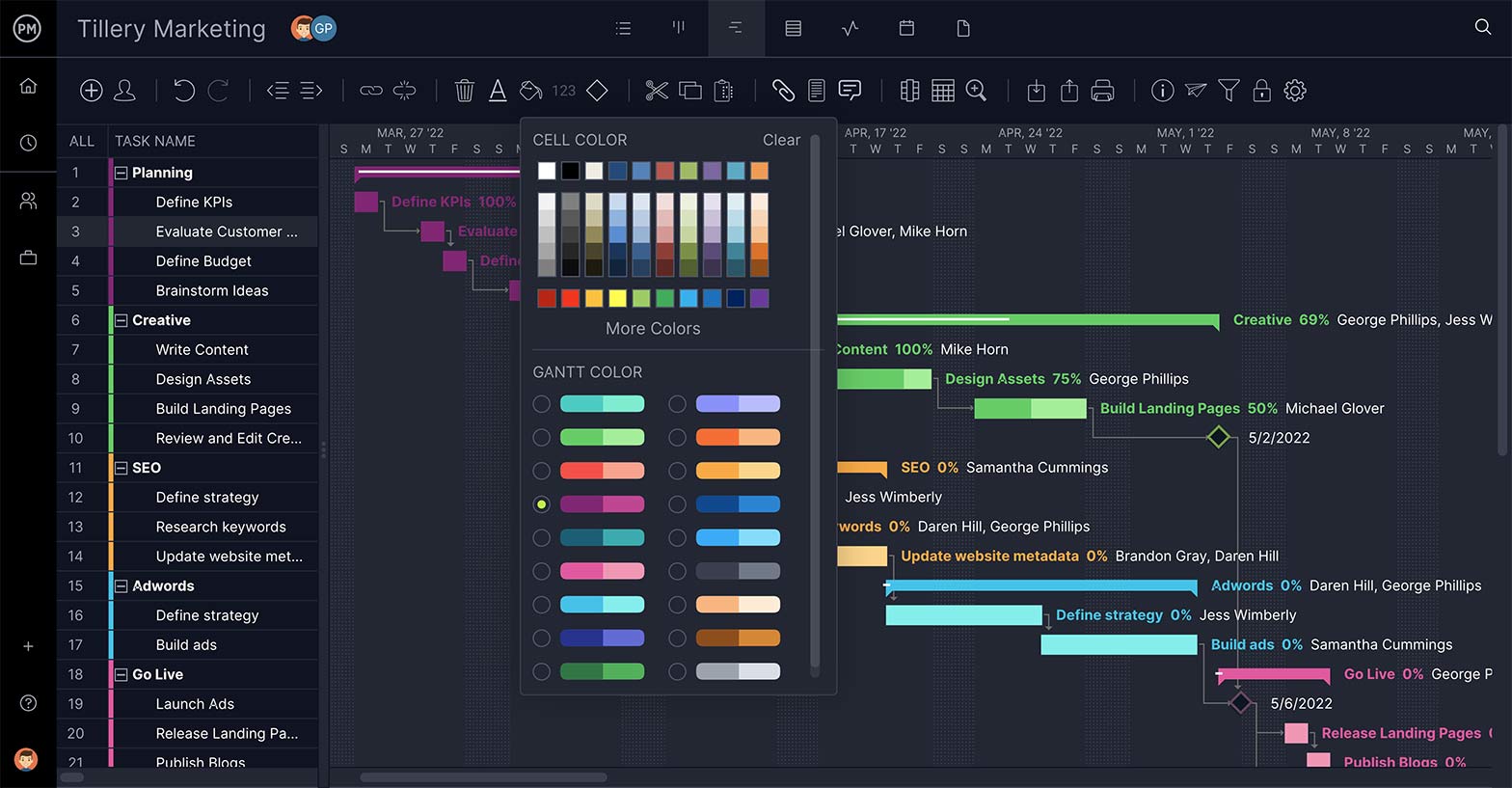
Control Your Task and Schedule
The Gantt chart is a waterfall’s best friend. It organizes your tasks, sets the duration and links tasks that are dependent to keep work flowing later on. When scheduling, you want a Gantt that can automatically calculate your critical path to help you know how much float you have.

Have Your Files Organized
Waterfall projects, like all projects, collect a lot of paperwork. You want a tool with the storage capacity to hold all your documents and make them easy to find when you need them. Also, attaching files to tasks gives teams direction and helps them collaborate.
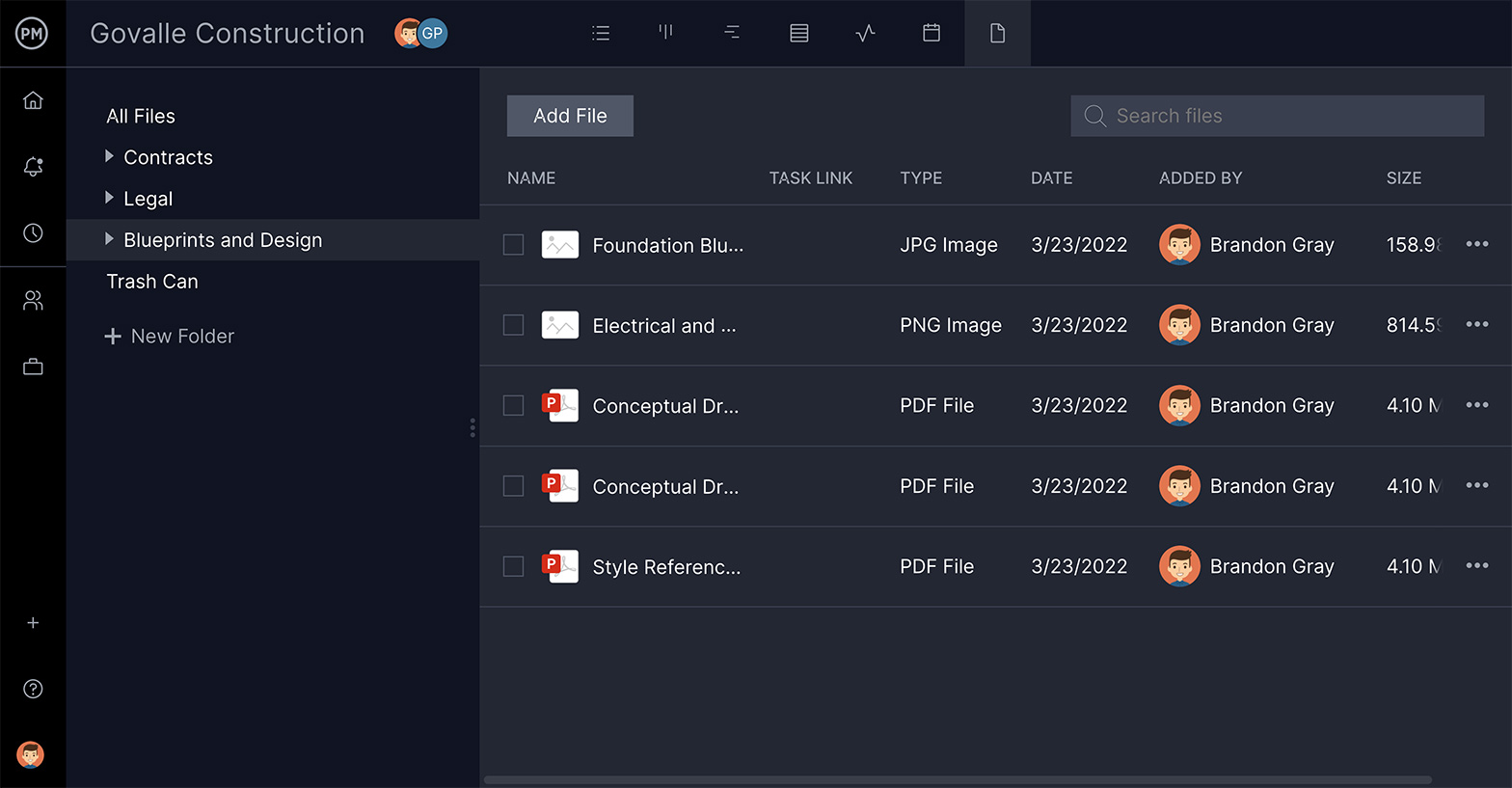
Know If You’re on Schedule
Keeping on track means having accurate information. Real-time data makes it timely, but you also need to set your baseline and have dashboard metrics and reporting to compare your actual progress to your planned progress. This makes sure you stay on schedule.
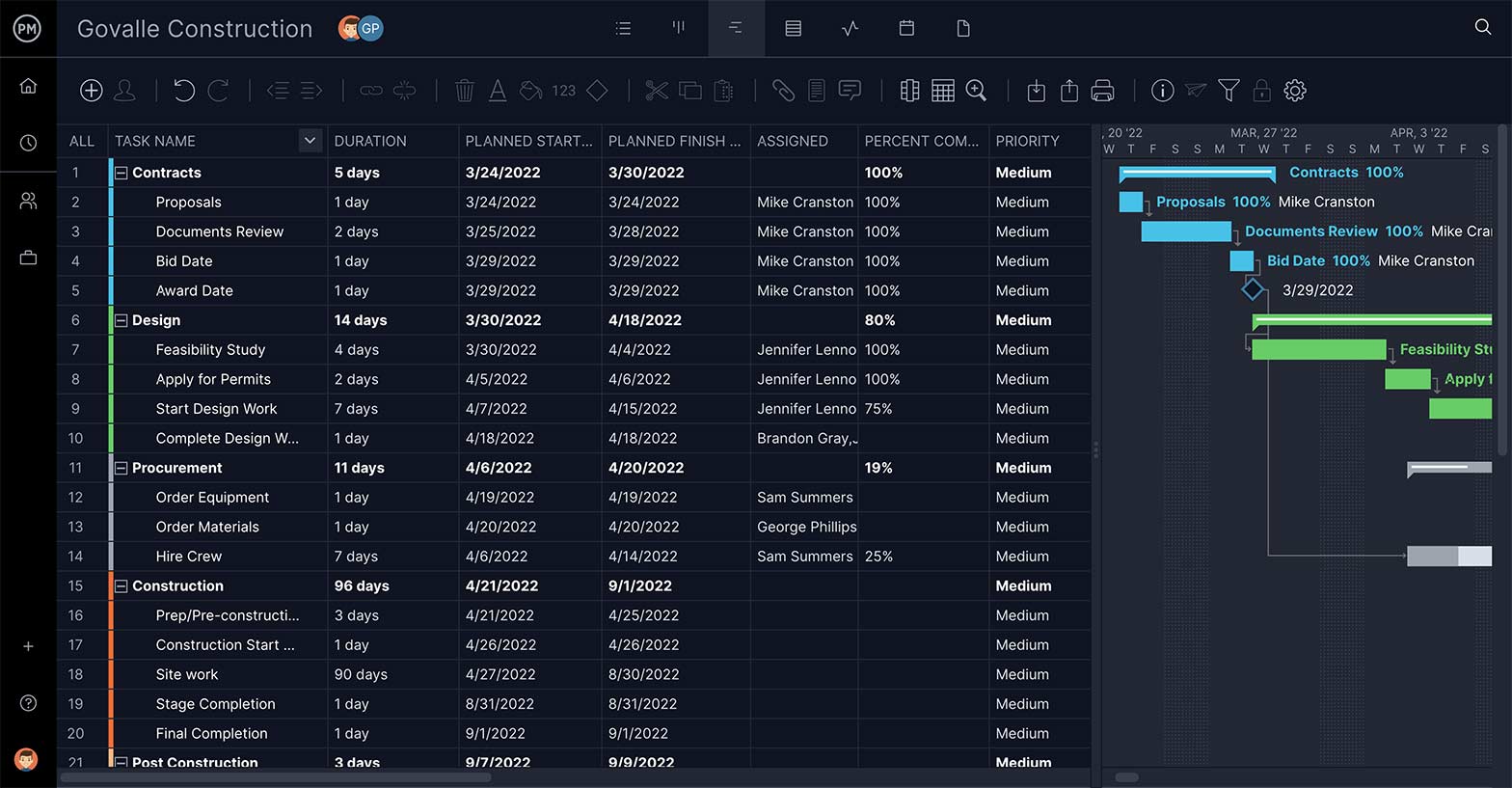
Get an Overview of Performance
Dashboards are designed to collect data and display it over several metrics, such as overall health, workload and more. This high-level view is important, so you want to have a feature that automatically calculates this data and doesn’t require you to manually input it.

Make Data-Based Decisions
Reports dive deeper into data and get more details on a project’s progress and performance. Real-time data makes them accurate. Look for ease of use—it should only take a single click to generate and share. You’ll also want to filter the results to see only what you’re interested in.

The Waterfall Model & ProjectManager
ProjectManager is an award-winning project management software that organizes teams and projects. With features such as online Gantt charts, task lists, reporting tools and more, it’s an ideal tool to control your waterfall project management.
Sign up for a free 30-day trial and follow along to make a waterfall project in just a few easy steps. You’ll have that Gantt chart built in no time!
1. Upload Requirements & Documents
Waterfall project management guarantees one thing: a lot of paperwork. All the documentation and requirements needed to address for the project can quickly become overwhelming.
You can attach all documentation and relevant files to our software, or directly on a task. Now, all of your files are collected in one place and are easy to find. Don’t worry about running out of space—we have unlimited file storage.
2. Use a Work Breakdown Structure to Collect Tasks
Getting to your final deliverable will require many tasks. Planning the waterfall project means knowing every one of those tasks, no matter how small, and how they lead to your final deliverable. A work breakdown structure is a tool to help you figure out all those steps.
To start, use a work breakdown structure (WBS) to collect every task that is necessary to create your final deliverable. You can download a free WBS template here. Then, upload the task list to our software.
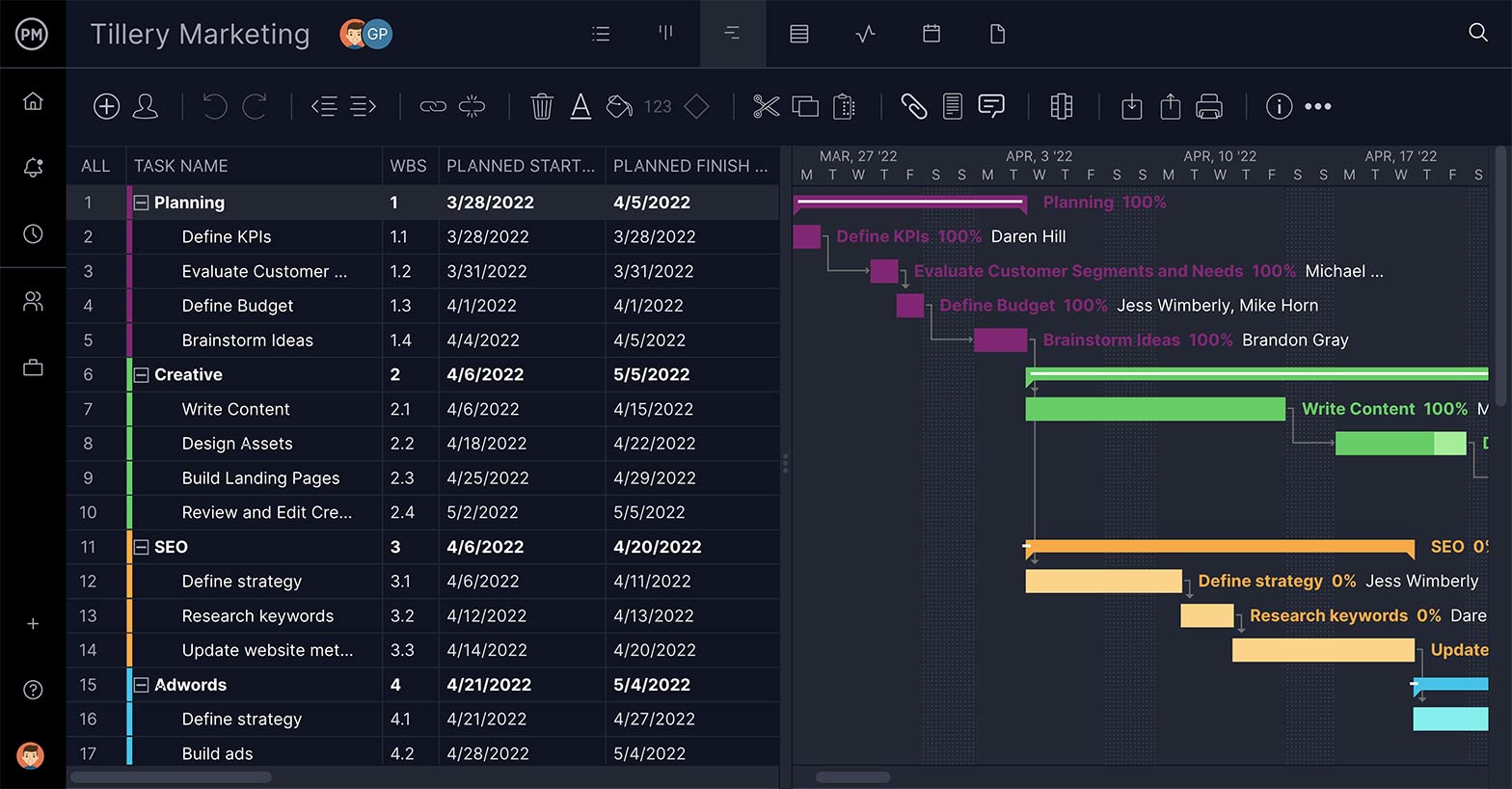
3. Open in Gantt Project View
Gantt charts are essential project management tools used for planning and scheduling. They collect your tasks in one place on a timeline. From there, you can link dependencies, set milestones, manage resources and more.
In the software, open the Gantt chart view and add deadlines, descriptions, priorities and tags to each task.

4. Create Phases & Milestones
Milestones are what separates major phases in a waterfall method project. Waterfall methodology is all about structure and moving from one phase to the next, so breaking your project into milestones is key to the waterfall method.
In the Gantt view, create phases and milestones to break up the project. Using the milestone feature, determine when one task ends and a new one begins. Milestones are symbolized by a diamond on the Gantt.
5. Set Dependencies in a Gantt Chart
Dependent tasks are those that cannot start or finish until another starts or finishes. They create complexities in managing any waterfall project.
Link dependent tasks in the Gantt chart. Our software allows you to link all four types of dependencies: start-to-start, start-to-finish, finish-to-finish and finish-to-start. This keeps your waterfall project plan moving forward in a sequential order and prevents bottlenecks.
6. Assign From Gantt Charts
Although you’ve planned and scheduled a project, it’s still just an abstraction until you get your team assigned to execute those tasks. Assigning is a major step in managing your waterfall project and needs to happen efficiently.
Assign team members to tasks right from the Gantt chart. You can also attach any related images or files directly to the task. Collaboration is supported by comments at the task level. Anyone assigned or tagged will get an email alert to notify them of a comment or update.
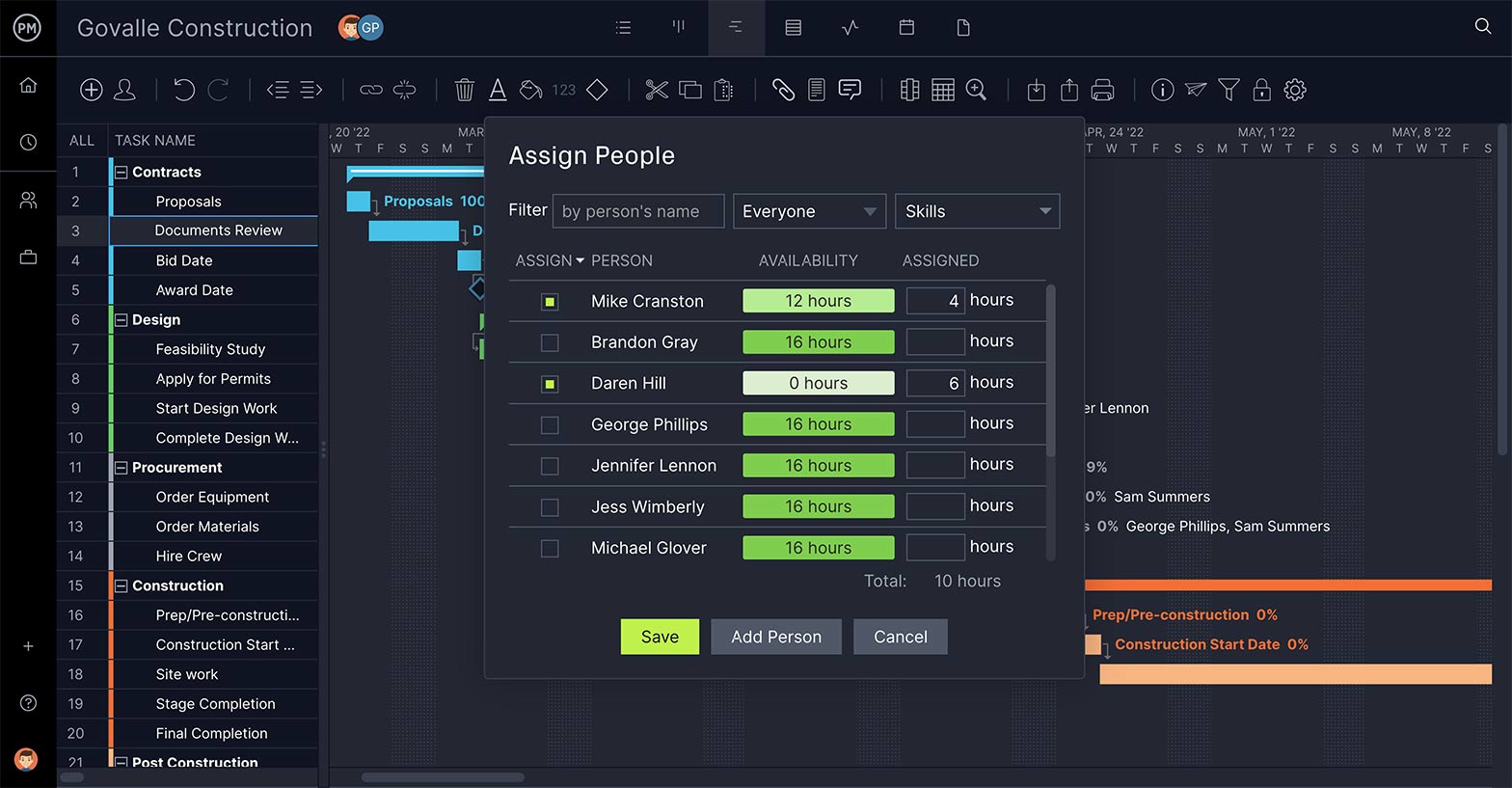
7. Manage Resources & Workload
Resources are anything you need to complete the project. This means not only your team, but also the materials and tools that they need. The workload represents how many tasks your team is assigned, and balancing that work keeps them productive.
Keep track of project resources on the Workload view. See actual costs, and reallocate as needed to stay on budget. Know how many tasks your team is working on with easy-to-read color-coded charts, and balance their workload right on the page.

8. Track Progress in Dashboard & Gantt
Progress must be monitored to know if you’re meeting the targets you set in your waterfall method plan. The Gantt shows percentage complete, but a dashboard calculates several metrics and shows them in graphs and charts.
Monitor your project in real time and track progress across several metrics with our project dashboard. We automatically calculate project health, costs, tasks and more and then display them in a high-level view of your project. Progress is also tracked by shading on the Gantt’s duration bar.

9. Create Reports
Reporting serves two purposes: it gives project managers greater detail into the inner-workings of their waterfall project to help them make better decisions, and acts as a communication tool to keep stakeholders informed.
Easily generate data-rich reports that show project variance, timesheets, status and more. Get reports on your planned vs. the actual progress. Filter to show just the information you want. Then, share with stakeholders during presentations and keep everyone in the loop.

10. Duplicate Plan for New Projects
Having a means to quickly copy projects is helpful in waterfall methodology, as it jumpstarts the next project by recreating the major steps and allowing you to make tweaks as needed.
Create templates to quickly plan any recurring waterfall projects. If you know exactly what it takes to get the project done, then you can make it into a template. Plus, you can import proven project plans from MSP, and task lists from Excel and Word.
Waterfall vs. Agile
The waterfall methodology is one of two popular methods to tackle software engineering projects; the other method is known as Agile.
It can be easier to understand waterfall when you compare it to Agile. Waterfall and Agile are two very different project management methodologies, but both are equally valid, and can be more or less useful depending on the project.
Waterfall Project Management
If the waterfall model is to be executed properly, each of the phases we outlined earlier must be executed in a linear fashion. Meaning, each phase has to be completed before the next phase can begin, and phases are never repeated—unless there is a massive failure that comes to light in the verification or maintenance phase.
Furthermore, each phase is discrete, and pretty much exists in isolation from stakeholders outside of your team. This is especially true in the requirements phase. Once the customer’s requirements are collected, the customers cease to play any role in the actual waterfall software development life cycle.
Agile Project Management
The agile methodology differs greatly from the waterfall approach in two major ways; namely in regards to linear action and customer involvement. Agile is a nimble and iterative process, where the product is delivered in stages to the customer for them to review and provide feedback.
Instead of having everything planned out by milestones, like in waterfall, the Agile software development method operates in “sprints” where prioritized tasks are completed within a short window, typically around two weeks.
These prioritized tasks are fluid, and appear based on the success of previous sprints and customer feedback, rather than having all tasks prioritized at the onset in the requirements phase.
Understanding the Difference Between Waterfall & Agile
The important difference to remember is that a waterfall project is a fixed, linear plan. Everything is mapped out ahead of time, and customers interact only at the beginning and end of the project. The Agile method, on the other hand, is an iterative process, where new priorities and requirements are injected into the project after sprints and customer feedback sessions.
Pros & Cons of the Waterfall Project Management
There are several reasons why project managers choose to use the waterfall project management methodology. Here are some benefits:
- Project requirements are agreed upon in the first phase, so planning and scheduling is simple and clear.
- With a fully laid out project schedule, you can give accurate estimates for your project cost, resources and deadlines.
- It’s easy to measure progress as you move through the waterfall model phases and hit milestones.
- Customers aren’t perpetually adding new requirements to the project, which can delay production.
Of course, there are drawbacks to using the waterfall method as well. Here are some disadvantages to this approach:
- It can be difficult for customers to articulate all of their needs at the beginning of the project.
- If the customer is dissatisfied with the product in the verification phase, it can be very costly to go back and design the code again.
- A linear project plan is rigid, and lacks flexibility for adapting to unexpected events.
Although it has its drawbacks, a waterfall project management plan is very effective in situations where you are encountering a familiar scenario with several knowns, or in software engineering projects where your customer knows exactly what they want at the onset.
Benefits of Project Management Software for Waterfall Projects
Using a project management software is a great way to get the most out of your waterfall project. You can map out the steps and link dependencies to see exactly what needs to go where.
As illustrated above, ProjectManager is made with waterfall methodology in mind, with a Gantt chart that can structure the project step-by-step. However, we have a full suite of features, including kanban boards that are great for Agile teams that need to manage their sprints.
With multiple project views, both agile and waterfall teams and more traditional ones can work from the same data, delivered in real time, only filtered through the project view most aligned to their work style. We take the waterfall methodology and bring it into the modern world.
Now that you know how to plan a waterfall project, give yourself the best tools for the job. Take a free 30-day trial and see how ProjectManager can help you plan with precision, track with accuracy and deliver your projects on time and under budget.
Waterfall Methodology Resources
Software
Templates
Start your free 30-day trial
Deliver faster, collaborate better, innovate more effectively — without the high prices and months-long implementation and extensive training required by other products.
Start free trial